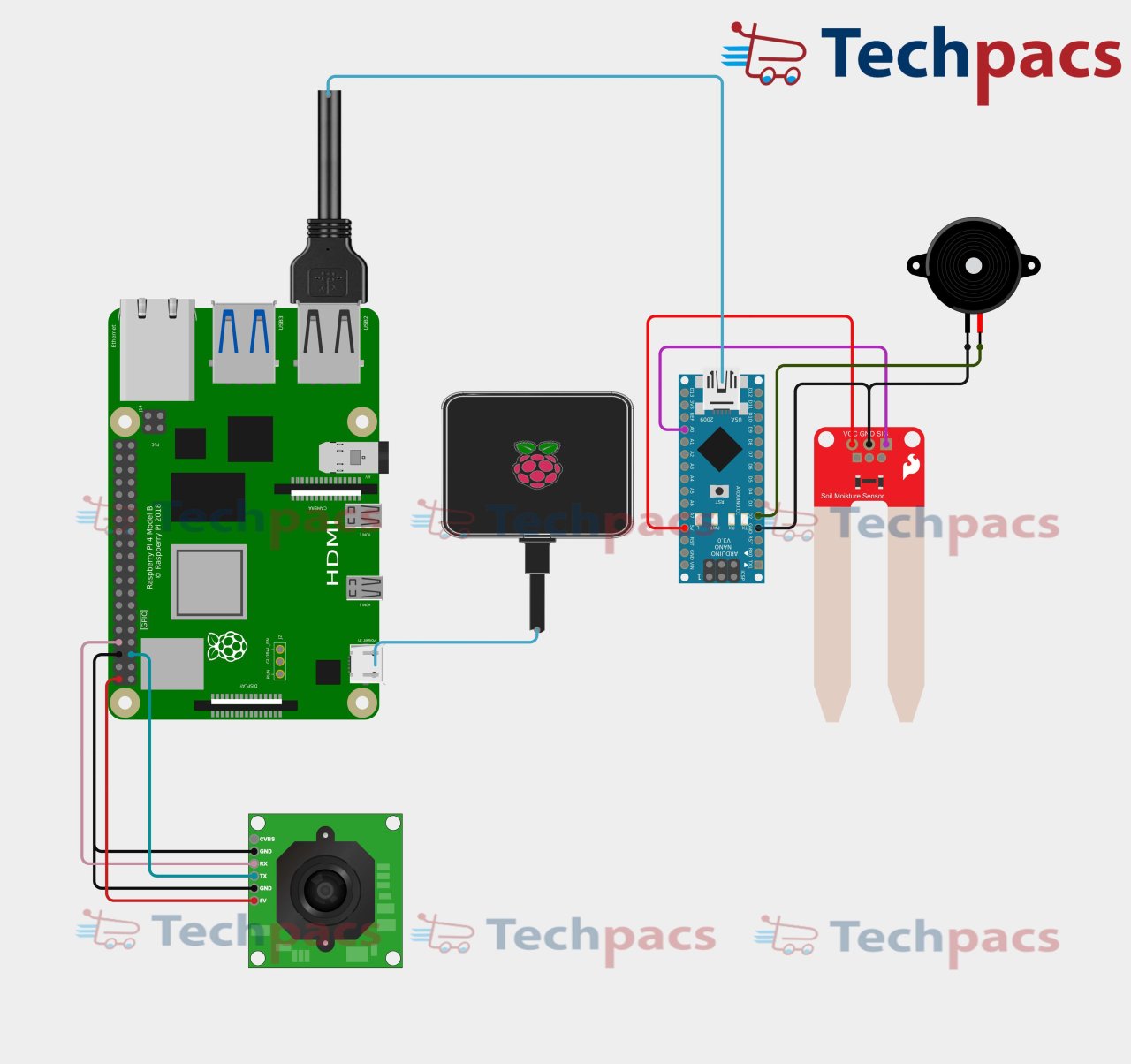Objectives
The primary objective of the AI-Powered Agriculture Automation project is to integrate advanced technology into farming practices to enhance efficiency and sustainability. This system leverages the power of Raspberry Pi and computer vision to automate various agricultural processes, reducing manual labor and increasing productivity. Specifically, the project aims to monitor farm environments in real-time, detect potential threats such as animals, birds, and fires, and optimize irrigation through precise soil moisture monitoring. By providing instant notifications and actionable data through a mobile app, the system empowers farmers to make informed decisions quickly, protecting their crops and livestock, conserving water, and ultimately improving crop yields. The overarching goal is to demonstrate how AI and IoT technologies can transform traditional farming into a more automated, efficient, and sustainable practice.
Key Features
The AI-Powered Agriculture Automation system boasts several key features designed to streamline farming operations:
-
Real-time Monitoring and Detection: Utilizing a web camera and computer vision algorithms, the system continuously scans the farm environment for the presence of animals, birds, and fires. Any detected threats trigger instant notifications sent to the farmer’s mobile app.
-
Soil Moisture Monitoring: Equipped with soil moisture sensors, the system provides accurate, real-time data on soil moisture levels. This information helps farmers avoid over or under-watering, optimizing water usage and ensuring healthy crop growth.
-
Mobile App Integration: The mobile app serves as the user interface, offering seamless access to notifications and data. Farmers can view real-time sensor data, receive alerts, and make irrigation decisions from their smartphones.
-
Efficient Data Management: The system uses a Raspberry Pi for processing and an Arduino Nano for managing sensor data, ensuring efficient communication and data handling between components.
-
Customizability: The project can be tailored to meet specific farming needs, making it a versatile solution for different agricultural environments.
Application Areas
This project has a wide range of applications in the agricultural sector:
-
Crop Farming: The system can be used in crop fields to monitor soil moisture and detect pests or animals that may harm the crops.
-
Livestock Farming: In areas where livestock is raised, the system can alert farmers to the presence of predators or fires, ensuring the safety of animals.
-
Greenhouses: In controlled environments like greenhouses, precise soil moisture monitoring can significantly improve water usage efficiency and plant health.
-
Orchards and Vineyards: The system can help in maintaining optimal soil conditions and protecting fruit crops from birds and other animals.
-
Remote Farms: For farms located in remote areas, real-time monitoring and alerts can help in managing the farm efficiently without constant physical presence.
Detailed Working
The AI-Powered Agriculture Automation system operates through a synergy of various components and technologies. At its core is the Raspberry Pi, which processes data from connected sensors and a web camera. The web camera captures images and videos of the farm environment, which are analyzed using computer vision algorithms to detect the presence of animals, birds, or fires. Upon detection, the system sends real-time notifications to the farmer’s mobile app, enabling immediate action.
Simultaneously, soil moisture sensors measure the moisture levels in the soil continuously. This data is transmitted to the Arduino Nano, which processes and forwards it to the Raspberry Pi. The Raspberry Pi then updates the mobile app with real-time soil moisture data, helping farmers make informed irrigation decisions.
The mobile app serves as the central hub for the farmer, displaying real-time data and notifications. It allows farmers to remotely monitor their farm, receive instant alerts, and access historical data to track trends and make data-driven decisions. This integration of hardware and software creates a robust system that enhances farm management through automation and real-time insights.

Modules Used
- Raspberry Pi: The central processing unit of the system, responsible for data processing and communication.
- Arduino Nano: Manages sensor data and ensures efficient communication between components.
- Web Camera: Captures images and videos for real-time monitoring and threat detection.
- Soil Moisture Sensors: Measure soil moisture levels to prevent over or under-watering.
- Mobile App: Interface for farmers to receive notifications and access data.
- Power Supply: Ensures that all components receive the necessary power to function efficiently.
- Wi-Fi Module: Provides connectivity for real-time data transmission and remote access.
Summary
The AI-Powered Agriculture Automation project leverages advanced technologies like Raspberry Pi and computer vision to create a smart farming solution. The system uses a web camera to monitor the farm environment for threats such as animals, birds, and fires, sending instant notifications to a mobile app for timely intervention. Additionally, soil moisture sensors provide real-time data to optimize irrigation and improve crop yields. The integration of these components, managed by Raspberry Pi and Arduino Nano, ensures efficient data handling and communication. This project demonstrates the potential of AI and IoT in transforming traditional farming into a more automated and sustainable practice, offering significant benefits in terms of efficiency, productivity, and resource management.
Technology Domains
- Artificial Intelligence: Utilized for computer vision algorithms to detect animals, birds, and fires.
- Internet of Things (IoT): Employed for real-time monitoring and data transmission between sensors, Raspberry Pi, and the mobile app.
- Embedded Systems: Integrates hardware components like Raspberry Pi, Arduino Nano, and sensors to create a cohesive system.
- Mobile Computing: Mobile app development for real-time notifications and data access.
- Data Analytics: Analyzing sensor data to provide actionable insights for farmers.
Technology Sub Domains
- Computer Vision: A subfield of AI used for analyzing images and videos to detect threats.
- Wireless Communication: Involves Wi-Fi modules for real-time data transmission.
- Sensor Technology: Utilizes soil moisture sensors to gather environmental data.
- Embedded C Programming: Used for programming the Arduino Nano.
- Python Programming: Used for processing data and developing algorithms on Raspberry Pi.
- Mobile App Development: Involves creating an intuitive and user-friendly interface for farmers.
| Shipping Cost |
|
No reviews found!


























































No comments found for this product. Be the first to comment!